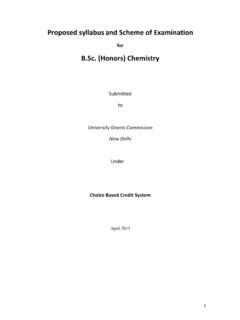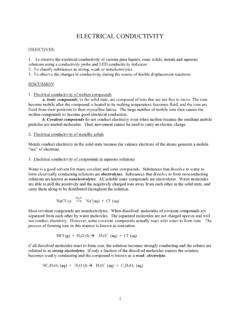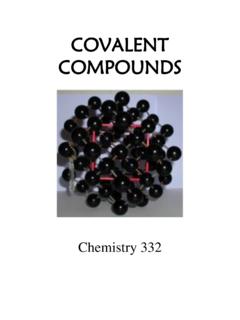Lab Ionic And Covalent
Found 5 free book(s)B.Sc.((Honors)(Chemistry( - UGC
ugc.ac.inCovalent character in ionic compounds, polarizing power and polarizability. Fajan’s rules and consequences of polarization. Ionic character in covalent compounds: Bond moment and dipole moment. Percentage ionic character from dipole moment and electronegativity difference. (iii) Metallic Bond: Qualitative idea of valence bond and band ...
Sugar or Salt? Ionic and Covalent Bonds
uu.eduLab 11 Sugar or Salt? Ionic and Covalent Bonds TN Standard 2.1: The student will investigate chemical bonding. Have you ever accidentally used salt instead of sugar? rinking tea that has been sweetened with salt or eating vegetables that have been salted with sugar tastes awful! Salt and sugar may look the same, but they obviously taste very ...
Intermolecular and Ionic Forces
web.gccaz.eduGCC CHM 151LL: Intermolecular and Ionic Forces ©GCC, 2013 page 4 of 12 Intermolecular and Ionic Forces Comparing IMF U sing Percent Evaporation: This lab will explore changing masses during evaporation of organic liquids. The decrease in mass is related to the strength of the intermolecular forces of attraction. Consider the strength of the forces
ELECTRICAL CONDUCTIVITY
www.cerritos.eduAll soluble ionic compounds are electrolytes. Water molecules are able to pull the positively and the negatively charged ions away from each other in the solid state, and carry them along to be distributed throughout the solution. NaCl (s) !"# Na+(aq) + Cl …
COVALENT
chemunlimited.comLab- Covalent Solubility Purpose- The purpose of this lab is to develop a series of solubility guidelines for covalent compounds. Safety: Goggles and Aprons must be worn Procedure- 1. Fill 7 test tubes ¾ full with tap water. 2. Using the small bottles provided, add 10 drops of each chemical to a test tube. 3.




